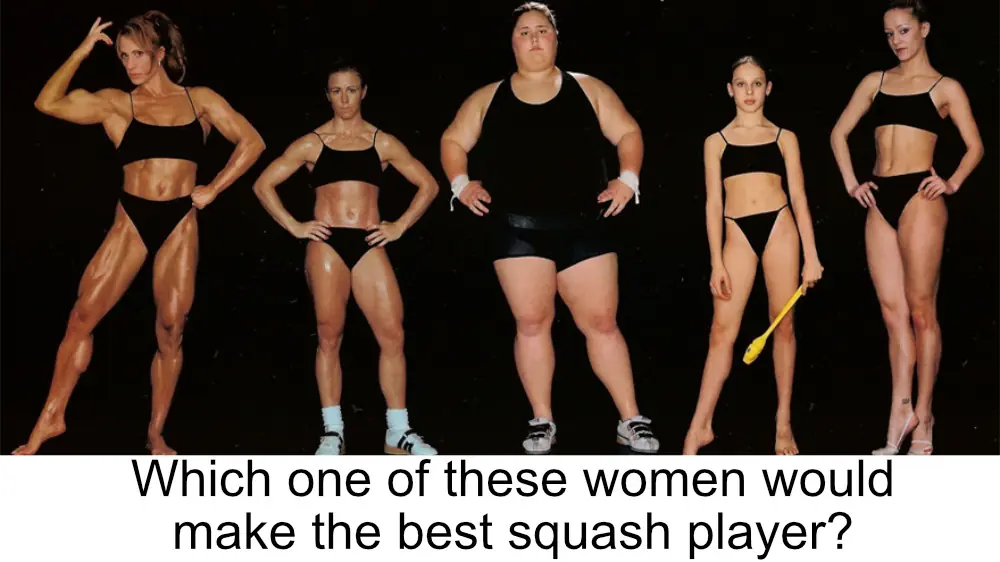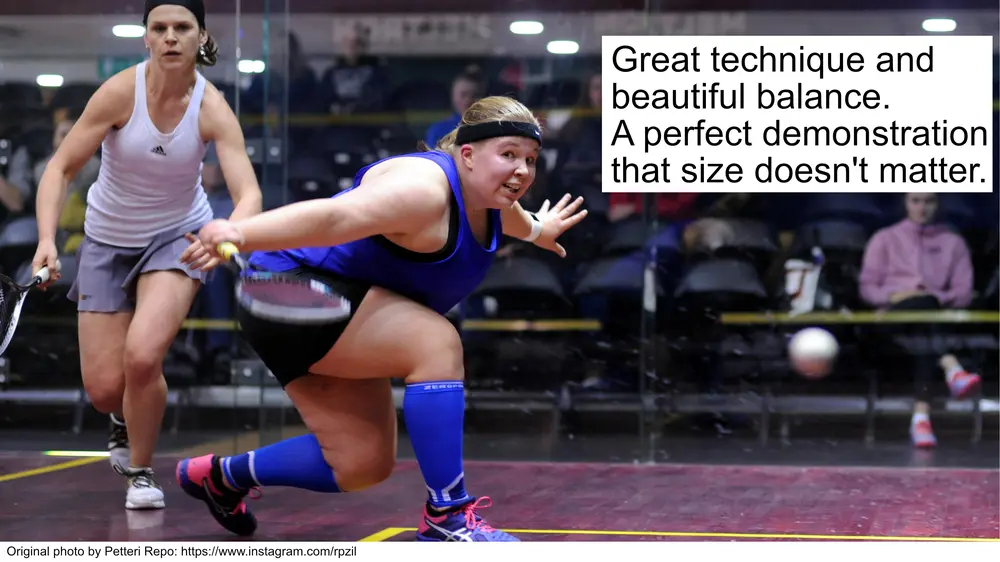25 November 2022 / 6-Min Read / Translate
Many years ago, I was chatting with somebody in the bar of the Wembley Squash Centre, where I was coach, and they said that they would love to try squash but were “too big”. “Nobody is too big unless they couldn’t fit through the door” I replied (partly joking, but looking back, quite true too), and the next week he was on the court with me. Admittedly, he really didn’t do very well, but that wasn’t due to his size.
Being “big” and you know what other word is associated with big, but I’m not going to use it, has always been a stumbling block for many who want to exercise. And let’s be clear, being big does cause some problems with regard to exercise, but unless there is a medical reason then I personally don’t see a problem in trying different sports.
Another time, I had an inter-club team match (my club versus another club) and the person who I was sharing the trip with warned me that “Mr. Smith” (yes, that really was his name) was a rather large fellow and I should not pre-judge him. On seeing him, I pre-judged him (silly 20 year-old me!) and thought it would be an easy night for me, but I was wrong, very wrong. I managed to beat him in 5 hard games, and he was one of the quietest players I had ever played. He seemed to glide around the court rather than the expected thump.
The Lesson: Big players can move surprisingly well sometimes.
I am lucky. I recognise that until recently (I am getting old), my body never stopped me from doing any activity I wanted to. Or more importantly my and society’s attitude never limited my options. Not everybody has that luxury. There should be nothing stopping people of all shapes or sizes from trying activities and sports.
Of course, it’s always sensible to try low-impact and non-combat sports first, as well as getting the okay from your doctor, but that might be true of everybody anyway.
Being big doesn’t mean you won’t have great eye-to-hand coordination. It doesn’t mean you can’t have great technique, it doesn’t mean you can’t “read” the game well and be tactically astute. It just means the physical aspect is going to be a challenge – but who wants things easy? Well, we all do, but sometimes it can’t be that way.
Being big may also mean you can really hit the ball hard, and let’s be totally honest, smacking the ball against the wall with a satisfying sound is a lot of fun. Why should you miss out on that?

Any guesses?
What a fascinating experiment it would be to take these 5 woman and put them through a 6-week squash beginner course. Which one would make the best squash player? Ask a few coaches and you would get different answers, but I honestly feel that it would be impossible to say. Clearly fitness is a very important aspect of squash, but it’s no use being the fittest person in the group if you can’t hit the ball well and to the right place!
I have taught young and old, fast and slow, big and small, tall and short, rich and poor, enthusiastic and uninterested, and I really don’t believe I can categorise them into standards.

The young lady in the photo above is Sanna Koivumäki, a squash player from Finland. Her highest world ranking was 147 back in 2018 and she now coaches in the USA. Clearly, Sanna is not the normal build of a squash player. But that didn’t stop her and it shouldn’t stop you. We connected via Petteri Repo, a photographer and squash player, via Instagram and she kindly agreed to answer some questions.
I started to play squash when I was 13, I did football and figure skating prior to picking up squash. When I went to high school, I decided to put all into squash and was fortunate to get in Mäkelänrinne High School which has special mission on sports. We had morning practices included to our schedule and they were also extremely supportive for tournaments abroad. I was selected into junior national teams and played couple junior Europeans as well. After graduating, I wanted to keep playing while getting my undergraduate degree and ended up going to United States, more specifically to St. Lawrence University. Last spring, I received my first adults national team call-up and I played at European Team Championships for Finland.
Fortunately no. My parents have always been very supportive whatever I wanted to do. If you train seriously, of course setbacks are part of the journey but these situations are always chance to learn and grow.
It’s been definitely not always pleasant but overtime I learned how to endure it and let it go. There has been comments made about my size, especially not being the typical body type, since I started playing squash. One time, some older male players said while I was playing that if you would be couple kilos lighter, you would have won that match after losing tightly.
Another situation, was talking with other female player and she just said that you should be eating less and it is so easy to lose weight to be better player. Despite just talking about two examples, there is more of course, but these two examples have just stayed with me longest. All of these comments of course hurt in first place but also makes me mad as the society makes pressures to fit into that one model.
Especially, hearing things like that in young age can make person to drop whole sport and that is definitely something that should never happen. Instead of saying this kind of commentating would be only squash world’s problem, it is not. It is simply the pressure that the whole society has. I think one beauty of this sport is that the players are coming from different backgrounds around the world and being different body types.
In recent years, I have been more serious about my strength training and started to do olympic weightlifting. All of the movements are very similar to the movements on court position and strength wise. I have been very fortunate that I have not having any major injuries and I think strength training has been a major contributor for that. I definitely highly recommend including strength training for any squash players weekly schedule. Multi joint movements (squat, clean, snatch, jerk, deadlift, etc.) strengthens the body in all different aspects and helps to build solid base to the court. Especially, leg strength is crucial when considering about the movements on court but also can be preventing those nagging knee injuries that you most often hear about.
I know it might be imitating to go and play in environment where people are expecting that one type of body type but squash is still one of the most effective ways of working out. Sweat is always quarantined and you will be amazed how you can improve on court. For many people, squash is such important socially so try to find the right group of people around you. I know it might be hard and take time, but when you find the right people around you, you start to feel good about yourself as well. Many times the one holding you back is yourself, so it is often overcoming yourself first but afterwards there is nothing preventing you! I still think it is one of the beauties of this sport is that it has something for everyone, no matter how they look or where they come.
I want to thank two PSA players who has spoken about their struggles of being outside of the expected body type for squash. Tesni Evans and Sarah-Jane Perry talked about the pressure this can create and both of them has been big inspiration for me and especially, to have similar courage to talk about stuff that is not often talked. I highly recommend checking these two videos from 2019 that was part of PSA’s It’s Mine-campaign. Video 1 and Video 2.